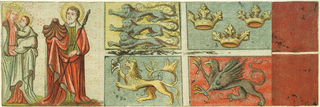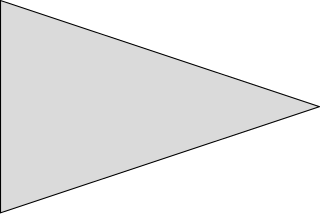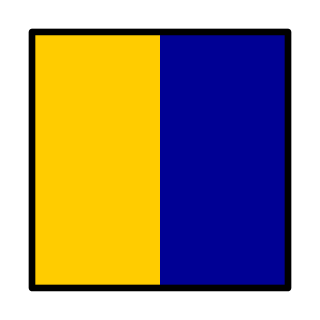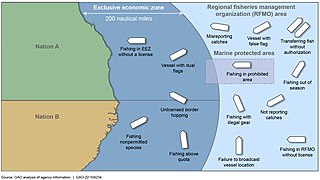
Flag of convenience (FOC) is a business practice whereby a ship's owners register a merchant ship in a ship register of a country other than that of the ship's owners, and the ship flies the civil ensign of that country, called the flag state. The term is often used pejoratively, and although common, the practice is sometimes regarded as contentious.

A maritime flag is a flag designated for use on ships, boats, and other watercraft. Naval flags are considered important at sea and the rules and regulations for the flying of flags are strictly enforced. The flag flown is related to the country of registration: so much so that the word "flag" is often used symbolically as a metonym for "country of registration".

International maritime signal flags are various flags used to communicate with ships. The principal system of flags and associated codes is the International Code of Signals. Various navies have flag systems with additional flags and codes, and other flags are used in special uses, or have historical significance.

The commissioning pennant is a pennant flown from the masthead of a warship. The history of flying a commissioning pennant dates back to the days of chivalry with their trail pendants being flown from the mastheads of ships they commanded. Today, the commissioning pennants are hoisted on the day of commissioning and not struck until they are decommissioned. Some navies have a custom of flying a "paying off" or "decommissioning pennant," the length of which often reflects the length of service of the warship.

A pennon, also known as a pennant or pendant, is a long narrow flag which is larger at the hoist than at the fly. It can have several shapes, such as triangular, tapering or triangular swallowtail, etc. In maritime use, pennants are to be hung from the main truck.
In the Royal Navy and other navies of Europe and the Commonwealth of Nations, ships are identified by pennant number. Historically, naval ships flew a flag that identified a flotilla or type of vessel. For example, the Royal Navy used a red burgee for torpedo boats and a pennant with an H for torpedo boat destroyers. Adding a number to the type-identifying flag uniquely identified each ship.
The Northwest Atlantic Fisheries Organization (NAFO) is an intergovernmental organization with a mandate to provide scientific advice and management of fisheries in the northwestern part of the Atlantic Ocean. NAFO is headquartered in Halifax, Nova Scotia, Canada.

The International Code of Signals (INTERCO) is an international system of signals and codes for use by vessels to communicate important messages regarding safety of navigation and related matters. Signals can be sent by flaghoist, signal lamp ("blinker"), flag semaphore, radiotelegraphy, and radiotelephony. The International Code is the most recent evolution of a wide variety of maritime flag signalling systems.

The European Fisheries Control Agency (EFCA) is the agency of the European Union (EU) that co-ordinates the national operational activities in the area of fisheries, and assists the member states in their application of the Common Fisheries Policy (CFP). The agency is based in Vigo,, Spain.

The National Oceanic and Atmospheric Administration (NOAA) operates a wide variety of specialized ships and aircraft to carry out NOAA's environmental and scientific missions.
The North Sea Fisheries Convention, officially known as the International Convention for regulating the police of the North Sea fisheries outside territorial waters, was a treaty that was signed on May 6, 1882. The inaugural conference was intended to provide a set of regulations for North Sea fisheries. The High Contracting Parties, which included Great Britain, Germany, Denmark, Netherlands, Belgium and France, entered the convention for a period of five years.

Illegal, unreported and unregulated fishing (IUU) is an issue around the world. Fishing industry observers believe IUU occurs in most fisheries, and accounts for up to 30% of total catches in some important fisheries.
Monitoring, control and surveillance (MCS), in the context of fisheries, is defined by the Food and Agriculture Organization (FAO) of the United Nations as a broadening of traditional enforcing national rules over fishing, to the support of the broader problem of fisheries management.

A pennant is a commemorative pennon typically used to show support for a particular athletic team. Pennants have been historically used in all types of athletic levels: high school, collegiate, professional etc. Traditionally, pennants were made of felt and fashioned in the official colors of a particular team.
Ship registration is the process by which a ship is documented and given the nationality of the country to which the ship has been documented. The nationality allows a ship to travel internationally as it is proof of ownership of the vessel.

The Canadian Naval Ensign is the flag worn at the stern or at the gaff of His Majesty's Canadian Ships. The ensign is also the flag of the Royal Canadian Navy (RCN) and is used on land in this capacity.

The Overseas Patrol Squadron is a front-line squadron of the Royal Navy with responsibility for patrolling the UK's Extended Fisheries Zone, both at home and around British Overseas Territories. The squadron, with headquarters at HMNB Portsmouth, is equipped with eight of the River-class patrol vessels.

Fisheries law is an emerging and specialized area of law. Fisheries law is the study and analysis of different fisheries management approaches such as catch shares e.g. Individual Transferable Quotas; TURFs; and others. The study of fisheries law is important in order to craft policy guidelines that maximize sustainability and legal enforcement. This specific legal area is rarely taught at law schools around the world, which leaves a vacuum of advocacy and research. Fisheries law also takes into account international treaties and industry norms in order to analyze fisheries management regulations. In addition, fisheries law includes access to justice for small-scale fisheries and coastal and aboriginal communities and labor issues such as child labor laws, employment law, and family law.













